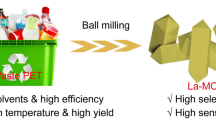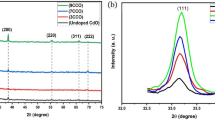Abstract
In this work, innovative biosourced polyimide polymers were derived from novel combinations of monomers (Isosorbide, 6-FDA and amine cardo). These polymers were obtained with satisfactory yields by polycondensation of different percentages of isosorbide and of 6-FDA (from 100% to 0%). The synthesized polyimides had number average molecular weight in the 17,600–22,000 g/mol range, and they were stable well above 451 °C (5% weight loss in N2). The glass transition temperature (Tg) were found to be in the range of 318–414 °C, depending on the composition of the copolymers. The adsorption of Water Framework Directive (WFD) heavy metals (Pb2+, Ni2+, Cd2+, Hg2+) on the biosourced polyimide films deposited on a gold electrode was monitored by the measurements of the impedance of the electrolyte/polyimide polymer/electrode interface. The adsorption isotherm of Pb2+on the different polyimide films was modeled according to a Langmuir isotherm with a best fitting. The relative adsorption capacities were higher when the isosorbide content was higher. Comparing the adsorption capacities of the different WFD heavy metals of the isosorbide based polyimide, the sequence is the following one: Pb2+ ≈ Ni2+ > Cd2+ > Hg2+. These results are within the paradigm of Pearson’s HSAB principle about the metal-oxygen interaction. When isosorbide based polyimide is the sensitive part of an impedimetric sensor, the detection limit for all the WFD heavy metals is 50 pM, very lower than the environmental quality standards for these WFD priority hazardous substances.





Similar content being viewed by others

Data Availability
The data that support the findings of this study are available from the corresponding author.
References
F. Fenglian, W. Qi, Removal of heavy metal ions from wastewaters: a review. J. Environ. Manag. 92, 407–418 (2011). https://doi.org/10.1016/j.jenvman.2010.11.011
E. Bazrafshan, L. Mohammadi, A. Ansari-Moghaddam, A.H. Mahvi, Heavy metals removal from aqueous environments by electrocoagulation process - A systematic review. J. Environ. Heal. Sci. Eng. 13 (2015). https://doi.org/10.1186/s40201-015-0233-8
A. Ahmed, Heavy metal pollution – a mini review. J. Bacteriol. Mycol. Open Access. 6, 179–181 (2018). https://doi.org/10.15406/jbmoa.2018.06.00199.006
A.T. Jan, M. Azam, K. Siddiqui, A. Ali, I. Choi, Q.M.R. Haq, Heavy metals and human health: mechanistic insight into toxicity and counter defense system of antioxidants. Int. J. Mol. Sci. 16, 29592–29630 (2015). https://doi.org/10.3390/ijms161226183
European Commission, EC, Commission Implementing Decision (EU) 2018/840 of 5 June 2018. Off. J. Eur. Union 141, 9–12 (2018)
A. Da̧browski, Z. Hubicki, P. Podkościelny, E. Robens, Selective removal of the heavy metal ions from waters and industrial wastewaters by ion-exchange method. Chemosphere 56, 91–106 (2004). https://doi.org/10.1016/j.chemosphere.2004.03.006
J. Esalah, M.M. Husein, Removal of heavy metals from aqueous solutions by precipitation-filtration using novel organo-phosphorus ligands. Sep. Sci. Technol. 43, 3461–3475 (2008). https://doi.org/10.1080/01496390802219661
A.E. Burakov, E.V. Galunin, I.V. Burakova, A.E. Kucherova, S. Agarwal, A.G. Tkachev, V.K. Gupta, Adsorption of heavy metals on conventional and nanostructured materials for wastewater treatment purposes: a review. Ecotoxicol. Environ. Saf. 148, 702–712 (2018). https://doi.org/10.1016/j.ecoenv.2017.11.034
D.L. Oatley-Radcliffe, M. Walters, T.J. Ainscough, P.M. Williams, A.W. Mohammad, N. Hilal, Nanofiltration membranes and processes: a review of research trends over the past decade. J. Water Proc. Eng. 19, 164–171 (2017). https://doi.org/10.1016/j.jwpe.2017.07.026
T.K. Tran, H.J. Leu, K.F. Chiu, C.Y. Lin, Electrochemical treatment of heavy metal-containing wastewater with the removal of COD and heavy metal ions. J. Chin. Chem. Soc. 64, 493–502 (2017). https://doi.org/10.1002/jccs.201600266
A. Waheed, M. Mansha, N. Ullah, Nanomaterials-based electrochemical detection of heavy metals in water: current status, challenges and future direction. TrAC Trends Anal. Chem. 105, 37–51 (2018). https://doi.org/10.1016/j.trac.2018.04.012
L. Eddaif, A. Shaban, J. Telegdi, Sensitive detection of heavy metals ions based on the calixarene derivatives-modified piezoelectric resonators: a review. Int. J. Environ. Anal. Chem. 99, 824–853 (2019). https://doi.org/10.1080/03067319.2019.1616708
T. Gong, J. Liu, X. Liu, J. Liu, J. Xiang, Y. Wu, A sensitive and selective sensing platform based on CdTe QDs in the presence of L-cysteine for detection of silver, mercury and copper ions in water and various drinks. Food Chem. 213, 306–312 (2016). https://doi.org/10.1016/j.foodchem.2016.06.091
V.N. Losev, O.V. Buyko, A.K. Trofimchuk, O.N. Zuy, Silica sequentially modified with polyhexamethylene guanidine and Arsenazo I for preconcentration and ICP-OES determination of metals in natural waters. Microchem. J. 123, 84–89 (2015). https://doi.org/10.1016/j.microc.2015.05.022
R. Sitko, P. Janik, B. Zawisza, E. Talik, E. Margui, I. Queralt, Green approach for ultratrace determination of divalent metal ions and arsenic species using total-reflection X-ray Fluorescence spectrometry and mercapto-modified graphene oxide nanosheets as a novel adsorbent. Anal. Chem. 87, 3535–3542 (2015). https://doi.org/10.1021/acs.analchem.5b00283
A.P.M. Michel, F. Sonnichsen, Laser induced breakdown spectroscopy for heavy metal detection in a sand matrix. Spectrochim. Acta Part B At. Spectrosc. 125, 177–183 (2016). https://doi.org/10.1016/j.sab.2016.10.001
C. Sarzanini, M.C. Bruzzoniti, Metal species determination by ion chromatography. TrAC Trends Anal. Chem. 20, 304–310 (2001). https://doi.org/10.1016/S0165-9936(01)00071-1.001
C.O.B. Okoye, A.M. Chukwuneke, N.R. Ekere, V.M.M. Melo, Simultaneous ultraviolet-visible (UVVIS) spectrophotometric quantitative determination of Pb, Hg, Cd, As and Ni ions in aqueous solutions using cyanidin as a chromogenic reagent. Int. J. Phys. Sci. 8, 98–102 (2013). https://doi.org/10.5897/ijps12.670
F. Zhao, Z. Chen, F. Zhang, R. Li, J. Zhou, Ultra-sensitive detection of heavy metal ions in tap water by laser-induced breakdown spectroscopy with the assistance of electrical-deposition. Anal. Methods 2, 408–414 (2010). https://doi.org/10.1039/b9ay00160c
R. Jain, S. Sharma, Glassy carbon electrode modified with multi-walled carbon nanotubes sensor for the quantification of antihistamine drug pheniramine in solubilized systems. J. Pharm. Anal. 2, 56–61 (2012). https://doi.org/10.1016/j.jpha.2011.09.013
L. Pujol, D. Evrard, K. Groenen-Serrano, M. Freyssinier, A. Ruffien-Cizsak, P. Gros, Electrochemical sensors and devices for heavy metals assay in water: the French groups’ contribution. Front. Chem. 2, 1–24 (2014). https://doi.org/10.3389/fchem.2014.00019
M. Miu, A. Angelescu, I. Kleps, M. Simion, Electrochemical sensors for heavy metals detection in liquid media. Int. J. Environ. Anal. Chem. 85(9–11), 675–679 (2005). https://doi.org/10.1080/03067310500146128
A.J. Borrill, N.E. Reily, J.V. Macpherson, Addressing the practicalities of anodic stripping voltammetry for heavy metal detection: a tutorial review. Analyst. 144, 6834–6849 (2019). https://doi.org/10.1039/c9an01437c.03067310500146128
Y. Lu, X. Liang, C. Niyungeko, J. Zhou, J. Xu, G. Tian, A review of the identification and detection of heavy metal ions in the environment by voltammetry. Talanta. 178, 324–338 (2018). https://doi.org/10.1016/j.talanta.2017.08.033
B.K. Bansod, T. Kumar, R. Thakur, S. Rana, I. Singh, A review on various electrochemical techniques for heavy metal ions detection with different sensing platforms. Biosens. Bioelectron. 94, 443–455 (2017). https://doi.org/10.1016/j.bios.2017.03.031
W. Ben Mefteh, H. Touzi, Y. Chevalier, F. Bessueille, R. Kalfat, N.J. Renault, Gold electrodes functionalized by methyl-naphthyl substituted cyclam films for the detection of metal ions. Sensors Actuators B Chem. 213, 334–342 (2015). https://doi.org/10.1016/j.snb.2015.02.109.031
L. Cui, J. Wu, H. Ju, Electrochemical sensing of heavy metal ions with inorganic, organic and bio-materials. Biosens. Bioelectron. 63, 276–286 (2015). https://doi.org/10.1016/j.bios.2014.07.052
C. Wang, R. Chu, Z. Guan, Z. Ullah, H. Song, Y. Zhang, C. Yu, L. Zhao, Q. Li, L. Liu, Tailored polyimide as positive electrode and polyimide-derived carbon as negative electrode for sodium ion full batteries. Nanoscale 12, 4729–4735 (2020). https://doi.org/10.1039/C9NR09237D
M. Akhtar, A. Tahir, S. Zulfiqar, F. Hanif, M.F. Warsi, P.O. Agboola, I. Shakir, Ternary hybrid of polyaniline-alanine-reduced graphene oxide for electrochemical sensing of heavy metal ions. Synth. Met. 265 (2020). https://doi.org/10.1016/j.synthmet.2020.116410
M. Lo, M. Seydou, A. Bensghaïer, R. Pires, D. Gningue-Sall, J.J. Aaron, Z. Mekhalif, J. Delhalle, M.M. Chehimi, Polypyrrole-wrapped carbon nanotube composite films coated on diazonium-modified flexible ITO sheets for the electroanalysis of heavy metal ions. Sensors (Switzerland) 20, 1–18 (2020). https://doi.org/10.3390/s20030580
E.K. Savan, S. Koytepe, A. Pasahan, G. Erdogdu, T. Seckin, Amperometric simultaneous measurement of copper and cobalt ions with polythiophene incorporating pendant terpyridine groups. Polym. Plast. Technol. Eng. 53, 1817–1824 (2014). https://doi.org/10.1080/03602559.2014.935405
H. Sanaeepur, A. Ebadi Amooghin, S. Bandehali, A. Moghadassi, T. Matsuura, B. Van der Bruggen, Polyimides in membrane gas separation: monomer’s molecular design and structural engineering. Prog. Polym. Sci. 91, 80–125 (2019). https://doi.org/10.1016/j.progpolymsci.2019.02.001
Y. Zhuang, J.G. Seong, Y.M. Lee, Polyimides containing aliphatic/alicyclic segments in the main chains. Prog. Polym. Sci. 92, 35–88 (2019). https://doi.org/10.1016/j.progpolymsci.2019.01.004
J. Boudaden, M. Steinmaßl, H.E. Endres, A. Drost, I. Eisele, C. Kutter, P. Müller-Buschbaum, Polyimide-based capacitive humidity sensor. Sensors (Switzerland). 18, 1–15 (2018). https://doi.org/10.3390/s18051516.01496390802219661
C.M. Nguyen, W.D. Huang, S. Rao, H. Cao, U. Tata, M. Chiao, J.C. Chiao, Sol-gel iridium oxide-based pH sensor array on flexible polyimide substrate. IEEE Sensors J. 13, 3857–3864 (2013). https://doi.org/10.1109/JSEN.2012.2236551
Y.Y. Lv, J. Wu, Z.K. Xu, Colorimetric and fluorescent sensor constructing from the nanofibrous membrane of porphyrinated polyimide for the detection of hydrogen chloride gas. Sensors Actuators B Chem. 148, 233–239 (2010). https://doi.org/10.1016/j.snb.2010.05.029
C. Wu, B.-O. Guan, C. Lu, H.-Y. Tam, Salinity sensor based on polyimide-coated photonic crystal fiber. Opt. Express 19, 20003 (2011). https://doi.org/10.1364/oe.19.020003
C. Zhang, S. Zhang, Y. Yan, F. Xia, A. Huang, Y. Xian, Highly fluorescent polyimide covalent organic nanosheets as sensing probes for the detection of 2,4,6-trinitrophenol. ACS Appl. Mater. Interfaces 9, 13415–13421 (2017). https://doi.org/10.1021/acsami.6b16423
Ö. Güngör, S. Köytepe, T. Seçkin, Polymer-plastics technology and engineering preparation of novel sensors based on polyimide membrane for sensitive and selective determination of dopamine. Polym.-Plast. Technol. Eng. 55(2), 119–128 (2015). https://doi.org/10.1080/03602559.2015.1055503
A. Alborzi, S. Zahmatkesh, A. Yazdanpanah, L-Lysine-derived optically active poly(hydrazide-imide)s: synthesis, characterization and their application in removal of heavy metal ions. Polym. Bull. 70, 3359–3372 (2013). https://doi.org/10.1007/s00289-013-1027-8
M.R. Vakili, S. Zahmatkesh, M.J. Panahiyan, T. Jafarizadeh, Poly(amide-hydrazide-imide)s containing L-aspartic acid: synthesis, characterization, and their applications in removal of heavy metal ions. Des. Monomers Polym. 18, 315–322 (2015). https://doi.org/10.1080/15685551.2014.999463
F. Fenouillot, A. Rousseau, G. Colomines, R. Saint-Loup, J.P. Pascault, Polymers from renewable 1,4:3,6-dianhydrohexitols (isosorbide, isomannide and isoidide): a review. Prog. Polym. Sci. 35, 578–622 (2010). https://doi.org/10.1016/j.progpolymsci.2009.10.001.8
W. Qiu, L. Xu, C.C. Chen, D.R. Paul, W.J. Koros, Gas separation performance of 6FDA-based polyimides with different chemical structures. Polymer 54, 6226–6235 (2013). https://doi.org/10.1016/j.polymer.2013.09.007.8
S. Mehdipour-Ataei, H. Arabi, N. Bahri-Laleh, New soluble, thermally stable poly(amide-imide)s containing cardo anthraquinone unit. Eur. Polym. J. 42, 2343–2351 (2006). https://doi.org/10.1016/j.eurpolymj.2006.06.006
G.O. Yahaya, I. Mokhtari, A.A. Alghannam, S.H. Choi, H. Maab, A.A. Bahamdan, Cardo-type random co-polyimide membranes for high pressure pure and mixed sour gas feed separations. J. Memb. Sci. 550, 526–535 (2018). https://doi.org/10.1016/j.memsci.2017.10.063
T. Chabbah, H. Abderrazak, R. Souissi, P. Saint-Martin, H. Casabianca, S. Chatti, R. Mercier, I. Rassas, A. Errachid, M. Hammami, N. Jaffrezic-Renault, A sensitive impedimetric sensor based on biosourced polyphosphine films for the detection of lead ions. Chemosensors 8(2), 34 (2020). https://doi.org/10.3390/CHEMOSENSORS8020034
Z. Mi, Z. Liu, J. Yao, C. Wang, C. Zhou, D. Wang, X. Zhao, H. Zhou, Y. Zhang, C. Chen, Transparent and soluble polyimide films from 1,4:3,6-dianhydro-D-mannitol based dianhydride and diamines containing aromatic and semiaromatic units: preparation, characterization, thermal and mechanical properties. Polym. Degrad. Stab. 151, 80–89 (2018). https://doi.org/10.1016/j.polymdegradstab.2018.01.006
A. Bashir, T. Manzoor, L.A. Malik, A. Qureashi, A.H. Pandith, Enhanced and selective adsorption of Zn(II), Pb(II), Cd(II), and Hg(II) Ions by a dumbbell- and flower-shaped potato starch phosphate polymer: a combined experimental and DFT calculation study. ACS Omega 5, 4853–4867 (2020). https://doi.org/10.1021/acsomega.9b03607.006
A. Sbartai, P. Namour, A. Errachid, J. Krejci, R. Sejnohova, L. Renaud, M.L. Hamlaoui, A.S. Loir, F. Garrelie, C. Donnet, H. Soder, E. Audouard, J. Granier, N. Jaffrezic-Renault, Electrochemical boron-doped diamond film microcells micromachined with femtosecond laser: application to the determination of water framework directive metals. Anal. Chem. 84, 4805–4811 (2012). https://doi.org/10.1021/ac3003598
M.R. Yaftian, M. Parinejad, D. Matt, A lead-selective membrane electrode based upon a phosphorylated hexahomotrioxacalix[3]arene. J. Chin. Chem. Soc. 54, 1535–1542 (2007). https://doi.org/10.1002/jccs.200700216
Funding
We would like to acknowledge the Financial support of CAMPUS-FRANCE and Institut Français of the French Embassy in Tunisia (Dr. Pierre Durand De Ramefort) for the SSHN grant, of the High Ministry of Education and Research in Tunisia for doctoral grant and European Commission for TUNWIN project Grant #952306.
Author information
Authors and Affiliations
Contributions
IJ: Investigation. FZ: Investigation. TC: Investigation. SC: Writing—original draft. PS-M: Methodology. HC: Conceptualization. SM: Methodology. FB: Methodology. CM: Conceptualization. RM: Conceptualization. AE: Funding acquisition. HA: Writing—original draft. MH: Funding acquisition. NJ-R: Writing—review and editing.
Corresponding author
Ethics declarations
Conflict of interest
The authors report no declarations of interest.
Additional information
Publisher's Note
Springer Nature remains neutral with regard to jurisdictional claims in published maps and institutional affiliations.
Supplementary Information
Rights and permissions
About this article
Cite this article
Jlalia, I., Zouaoui, F., Chabbah, T. et al. Adsorption Characteristics of WFD Heavy Metal Ions on New Biosourced Polyimide Films Determined by Electrochemical Impedance Spectroscopy. J Inorg Organomet Polym 31, 2471–2482 (2021). https://doi.org/10.1007/s10904-020-01842-w
Received:
Accepted:
Published:
Issue Date:
DOI: https://doi.org/10.1007/s10904-020-01842-w



